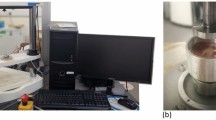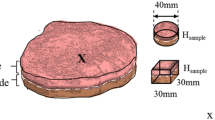Abstract
Maternal trauma (MT) in automotive collisions is a source of injury, morbidity, and mortality for both mothers and fetuses. The primary associated pathology is placental abruption in which the placenta detaches from the uterus leading to hemorrhaging and termination of pregnancy. In this study, we focused on the differences in placental tissue response to different stress states (tension, compression, and shear) and different strain rates. Human placentas were obtained (n = 11) for mechanical testing and microstructure analysis. Specimens (n = 4+) were tested in compression, tension, and shear, each at three strain rates (nine testing protocols). Microstructure analysis included scanning electron microscopy, histology, and interrupted mechanical tests to observe tissue response to various loading states. Our data showed the greatest stiffness in tension, followed by compression, and then by shear. The study concludes that mechanical behavior of human placenta tissue (i) has a strong stress state dependence and (ii) behaves in a rate dependent manner in all three stress states, which had previously only been shown in tension. Interrupted mechanical tests revealed differences in the morphological microstructure evolution that was driven by the kinematic constraints from the different loading states. Furthermore, these structure–property data can be used to develop high fidelity constitutive models for MT simulations.








Similar content being viewed by others
References
Abbassi-Ghanavati, M., B. M. Casey, C. Y. Spong, D. D. McIntire, L. M. Halvorson, and F. G. Cunningham. Pregnancy outcomes in women with thyroid peroxidase antibodies. Obstet. Gynecol. 116:381–386, 2010.
Aboutanos, M. B. M. D. M. P. H., S. Z. M. D. Aboutanos, D. B. S. Dompkowski, T. M. M. D. Duane, A. K. M. D. Malhotra, and R. R. M. D. Ivatury. Significance of motor vehicle crashes and pelvic injury on fetal mortality: a five-year institutional review. J. Trauma-Inj. Infect. Crit. Care 65:616–620, 2008.
Ananth, C. V., Y. Oyelese, L. Yeo, A. Pradhan, and A. M. Vintzileos. Placental abruption in the united states, 1979 through 2001: temporal trends and potential determinants. Am. J. Obstet. Gynecol. 192:191–198, 2005.
Ananth, C. V., D. A. Savitz, and M. A. Williams. Placental abruption and its association with hypertension and prolonged rupture of membranes: a methodologic review and meta-analysis. Obstet. Gynecol. 88:309–318, 1996.
Begonia, M., R. Prabhu, J. Liao, M. Horstemeyer, and L. Williams. The influence of strain rate dependency on the structure–property relations of porcine brain. Ann. Biomed. Eng. 38:3043–3057, 2010.
Carew, E. O., J. Patel, A. Garg, P. Houghtaling, E. Blackstone, and I. Vesely. Effect of specimen size and aspect ratio on the tensile properties of porcine aortic valve tissues. Ann. Biomed. Eng. 31:526–535, 2003.
Chames, M. C. M., and M. D. M. Pearlman. Trauma during pregnancy: outcomes and clinical management. Clin. Obstet. Gynecol. 51:398–408, 2008.
Clemmer, J., J. Liao, D. Davis, M. F. Horstemeyer, and L. N. Williams. A mechanistic study for strain rate sensitivity of rabbit patellar tendon. J. Biomech. 43:2785–2791, 2010.
Colgan, N. C., M. D. Gilchrist, and K. M. Curran. Applying DTI white matter orientations to finite element head models to examine diffuse TBI under high rotational accelerations. Prog. Biophys. Mol. Biol. 103:304–309, 2010.
Connolly, A. M., V. L. Katz, K. L. Bash, M. J. McMahon, and W. F. Hansen. Trauma and pregnancy. Am. J. Perinatol. 14:331–336, 1997.
Daria, C. R. Trauma care and managing the injured pregnant patient. J. Obstet. Gynecol. Neonatal. Nurs. 38:704–714, 2009.
Delotte, J., M. Behr, L. Thollon, P.-J. Arnoux, P. Baque, A. Bongain, and C. Brunet. Pregnant woman and road safety: experimental crash test with post mortem human subject. Surg. Radiol. Anat. 30:185–189, 2008.
Dighe, M., A. Gokhale, and M. Horstemeyer. Effect of loading condition and stress state on damage evolution of silicon particles in an Al–Si–Mg-base cast alloy. Metall. Mater. Trans. A 33:555–565, 2002.
Duma, S. M. Pregnant Occupants Biomechanics: Advances in Automobile Safety Research. Warrendale, PA: Society of Automotive Engineers, 2010.
Fung, Y. C. Biomechanics: Mechanical Properties of Living Tissues. New York: Springer, 1981.
Gao, Z., and J. P. Desai. Estimating zero-strain states of very soft tissue under gravity loading using digital image correlation. Med. Image Anal. 14:126–137, 2010.
Hall, D. R. Abruptio placentae and disseminated intravascular coagulopathy. Semin. Perinatol. 33:189–195, 2009.
Hitosugi, M., Y. Motozawa, M. Kido, T. Yokoyama, H. Kawato, K. Kuroda, and S. Tokudome. Traffic injuries of the pregnant women and fetal or neonatal outcomes. Forensic Sci. Int. 159:51–54, 2006.
Horstemeyer, M. F., J. Lathrop, A. M. Gokhale, and M. Dighe. Modeling stress state dependent damage evolution in a cast Al–Si–Mg aluminum alloy. Theor. Appl. Fract. Mech. 33:31–47, 2000.
Hu, J., K. D. Klinich, C. S. Miller, G. Nazmi, M. D. Pearlman, L. W. Schneider, and J. D. Rupp. Quantifying dynamic mechanical properties of human placenta tissue using optimization techniques with specimen-specific finite-element models. J. Biomech. 42:2528–2534, 2009.
Hu, J., K. Klinich, C. Miller, J. Rupp, G. Nazmi, M. Pearlman, and L. Schneider. A stochastic visco-hyperelastic model of human placenta tissue for finite element crash simulations. Ann. Biomed. Eng. 39:1074–1083, 2011.
Kastelic, J., and E. Baer. Deformation of tendon collagen. In: The Mechanical Properties of Biological Materials, edited by J. F. Vincient, and J. D. Currey. Cambridge: Society for Experimental Biology, 1980, pp. 397–433.
Klinich, K. D., C. A. C. Flannagan, J. D. Rupp, M. Sochor, L. W. Schneider, and M. D. Pearlman. Fetal outcome in motor-vehicle crashes: effects of crash characteristics and maternal restraint. Am. J. Obstet. Gynecol. 198:450.e451–450.e459, 2008.
Lee, J. B., and K. H. Yang. Development of a finite element model of the human abdomen. Stapp Car Crash J. 45:79–100, 2001.
Liao, J., L. Yang, J. Grashow, and M. S. Sacks. The relation between collagen fibril kinematics and mechanical properties in the mitral valve anterior leaflet. J. Biomech. Eng. 129:78–87, 2007.
Manoogian, S. J., J. A. Bisplinghoff, C. McNally, A. R. Kemper, A. C. Santago, and S. M. Duma. Dynamic tensile properties of human placenta. J. Biomech. 41:3436–3440, 2008.
Manoogian, S. J., J. A. Bisplinghoff, C. McNally, A. R. Kemper, A. C. Santago, and S. M. Duma. Effect of strain rate on the tensile material properties of human placenta. J. Biomech. Eng. 131:091008, 2009.
Mattox, K. L. M. D., and L. M. D. Goetzl. Trauma in pregnancy. Crit. Care Med. Crit. Illn. Pregnancy 33:S385–S389, 2005.
Moorcroft, D. M., J. D. Stitzel, G. G. Duma, and S. M. Duma. Computational model of the pregnant occupant: predicting the risk of injury in automobile crashes. Am. J. Obstet. Gynecol. 189:540–544, 2003.
Moorcroft, D., J. Stitzel, S. Duma, and G. Duma. The effects of uterine ligaments on fetal injury risk in frontal automobile crashes. Proc. Inst. Mech. Eng. D: J. Automob. Eng. 217:1049–1055, 2003.
Motozawa, Y., M. Hitosugi, T. Abe, and S. Tokudome. Effects of seat belts worn by pregnant drivers during low-impact collisions. Am. J. Obstet. Gynecol. 203(1):62.e1–62.e8, 2010.
Nyein, M. K., A. M. Jason, L. Yu, C. M. Pita, J. D. Joannopoulos, D. F. Moore, and R. A. Radovitzky. In silico investigation of intracranial blast mitigation with relevance to military traumatic brain injury. Proc. Natl. Acad. Sci. 107:20703–20708, 2010.
Oxford, C. M. M., and J. B. Ludmir. Trauma in pregnancy. Clin. Obstet. Gynecol. 52:611–629, 2009.
Rupp, J. D. K. K., S. Moss, J. Zhou, M. D. Pearlman, and L. W. Schneider. Development and testing of a prototype pregnant abdomen for the small-female hybrid III ATD. Stapp Car Crash J. 45:18, 2001.
Viidik, A. Simultaneous mechanical and light microscopic studies of collagen fibers. Zeitschrift fur Anatomie und Entwicklungsgeschichte 136:204–212, 1972.
Weaver, A. A., K. L. Loftis, S. M. Duma, and J. D. Stitzel. Biomechanical modeling of eye trauma for different orbit anthropometries. J. Biomech. 44:1296–1303, 2011.
Wren, T. A., and D. R. Carter. A microstructural model for the tensile constitutive and failure behavior of soft skeletal connective tissues. J. Biomech. Eng. 120:55–61, 1998.
Yamada, H. Strength of Biological Materials. Baltimore: Williams and Wilkinson, 1970.
Yu, M., S. Manoogian, S. M. Duma, and J. D. Stitzel. Finite element modeling of human placental tissue. Ann. Adv. Automot. Med. 53:257–270, 2009.
Acknowledgments
This study is supported by the MAFES SRI (awarded to JL) and Health Resources and Services Administration (HRSA) (DHHS R1CRH10429-01-00). We thank Karen Tiffen, RNC, Chrissy Poole, RNC, Dana Brooks, RNC, Cindy Patton, RN, Heather McMillian, ST, Bella Oswalt, ST, Sonya Anderson, RN, Rene Guines, ST, and other staff members of the Labor & Delivery Unit at OCH Regional Medical Center for their assistance with patient eligibility and tissue procurement; we also appreciate help from Amanda Lawrence (MSU EM Center) for her assistance in SEM imaging. We would also like to thank the Center for Advanced Vehicular Systems (CAVS) at the Mississippi State University for helping to support this research effort.
Author information
Authors and Affiliations
Corresponding author
Additional information
Associate Editor Stefan M. Duma oversaw the review of this article.
Rights and permissions
About this article
Cite this article
Weed, B.C., Borazjani, A., Patnaik, S.S. et al. Stress State and Strain Rate Dependence of the Human Placenta. Ann Biomed Eng 40, 2255–2265 (2012). https://doi.org/10.1007/s10439-012-0588-2
Received:
Accepted:
Published:
Issue Date:
DOI: https://doi.org/10.1007/s10439-012-0588-2




